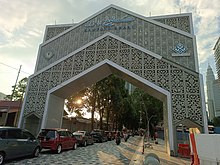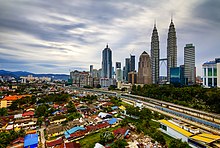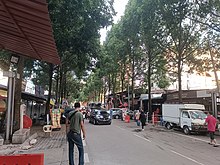Kampung Baru, Kuala Lumpur



Kampung Baru or Kampong Bharu (meaning "New Village") is a Malay enclave in central Kuala Lumpur, Malaysia. One of the most valuable tracts of land in the capital, it has been estimated to be worth up to US$1.4 billion.[citation needed]
Location
[edit]Kampung Baru is located in the northern part of Kuala Lumpur's central business district. It is separated from KLCC district by a section of the Klang River.
Kampung Baru is bordered by Jalan Tun Razak in the north, Jalan Tuanku Abdul Rahman in the west, Jalan Dewan Sultan Sulaiman in the southwest, and the Klang River and the Ampang-KL toll road (E 12) in the southeast.
Clockwise, from north to south, Kampung Baru borders Titiwangsa, Dato' Keramat, Ampang Hilir, KLCC, Medan Tuanku and Chow Kit.
History
[edit]
Kampung Baru was established in 1899 by a grant from the then-Sultan of Selangor, Sultan Alaeddin Suleiman Shah, to allow the Malays to retain their village lifestyle within the city.[1] It was formally gazetted as the Malay Agricultural Settlement in 1950.[2]
Since then Kampung Baru has held out against development and modern-city living, turning into a political symbol of Malay culture.
The area held a special place for Malay politics during the pro-independence movement that grew up after World War II. Kampung Baru is home to the Sultan Sulaiman Club (3°9′41.35″N 101°42′3.75″E / 3.1614861°N 101.7010417°E), where anti-colonial political gatherings were often held, including those that led to the formation of the United Malays National Organisation (UMNO), Malaysia's ruling party since independence until 2018, and then again since 2021.[3] Documents dating back to the period were unearthed at the grounds of the Club several years ago.
Kampung Baru, which sprawls over almost 4 km2, was among the hardest-hit areas during the May 13 Incident in 1969, where bloody racial clashes occurred between ethnic Malays and Chinese. The riots started after Chinese-led opposition parties marched through the village to celebrate their good showing in general elections of that year. New research (May 13: Declassified Documents on the Malaysian Riots of 1969) based on newly declassified documents at the Public Records Office in London, the book alleged that contrary to the official account which had blamed the violence on opposition parties, the riot had been intentionally started by the "ascendent state capitalist class" in UMNO as a coup d'état to topple the Tunku from power.
In recent years, Kampung Baru also played a central role in the Reformasi protests of 1998, when former deputy premier Anwar Ibrahim launched protests against then premier Mahathir Mohamad, calling for reforms to government and the judiciary.
Developments
[edit]
Plans to redevelop Kampung Baru had been around since the 2000s, and intensified in recent years. Negotiations between kampung residents and successive governments have been ongoing since 2018.[4][5][6]
Amenities and notable landmarks
[edit]


Healthcare
[edit]Kampung Baru district is notable for being home to Kuala Lumpur Hospital and the National Heart Institute.
Other landmarks
[edit]- Kelab Sultan Sulaiman
- Galeri Kelab Sultan Sulaiman
- National Library of Malaysia
- KJ11 Kampung Baru station, part of the LRT Kelana Jaya Line of Rapid KL
- PY19 Raja Uda station, part of the MRT Putrajaya Line of Rapid KL, serving the northern end of Kampung Baru.
- NAZA Group headquarters
- Masjid Jamek Kampung Baru
- Rumah Limas Kampung Baru
- Master Mat's House
- Tatt Khalsa Diwan Gurdwara
- Jalan Raja Muda Musa
- Jalan Raja Alang
- Sikh Temple
- Saloma Link
Access
[edit]KJ11 Kampung Baru metro station, served by the Rapid KL LRT Kelana Jaya Line, is located in the southern part of Kampung Baru.
MR10 Chow Kit Monorail station is located at the western end of Kampung Baru.
PY19 Raja Uda MRT station, served by the MRT Putrajaya Line, located in the northern part of Kampung Baru.
Bus routes running through Kampung Baru include 220 and 302.
The Saloma Link pedestrian bridge, spanning the Klang River and the Ampang-Kuala Lumpur toll road, is a shortcut from Kampung Baru to the Petronas Towers.
Notable residents
[edit]- Tan Sri S.M. Salim - Malaysian singer
- Tan Sri SM Nasimuddin SM Amin - Naza Group Chairman
- Tan Sri Dato' Azman Hashim - AmBank Group Chairman
- Dato' Mohamed Azlan Hashim - Proton Ex Chairman
- Dato' Zainal Abidin Putih - Chairman CIMB Bank Bhd.
- Dato Mat Shah Safuan - businessman
- Dato Seri Drs Suleiman Mohamed - former Deputy Minister of Information, politician
- Allahyarham M Shariff - Malaysian singer
- Sheikh Hassan bin Sheikh Mubarak - businessman, trader
See also
[edit]References
[edit]- ^ "Sejarah Kampung Melayu yang perlu anda tahu". Astro Awani. Retrieved 7 December 2021.
- ^ "Menjejak pewaris Kampung Baru". Malaysiakini. Retrieved 7 December 2021.
- ^ "Sultan Sulaiman Club's heritage building has seen better times". Free Malaysia Today. Retrieved 7 December 2021.
- ^ "Kg Baru redevelopment has landowners on tenterhooks". Malaysiakini. Retrieved 7 December 2021.
- ^ "Malaysia's capital Kuala Lumpur seeks to free village 'trapped in time' in shadow of Petronas Towers". Straits Times. Retrieved 7 December 2021.
- ^ "Why the low value for Kg Baru land, asks Najib". Free Malaysia Today. Retrieved 7 December 2021.
- Planet Ark - Malay Village Clings Onto its City-Centre Address
- New documents suggest Umno has origins in KL, The Star, 14 December 2007.
- Kampung Baru plan expected out in April, The Star, 26 January 2008.
